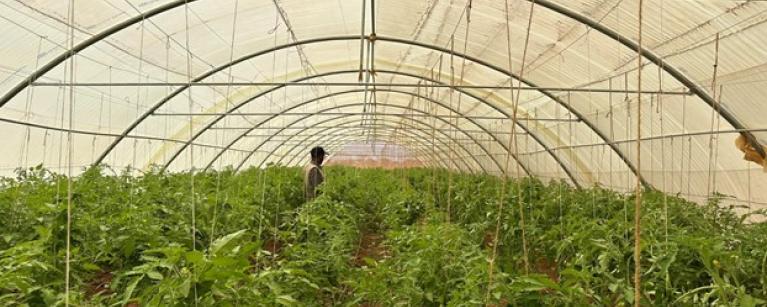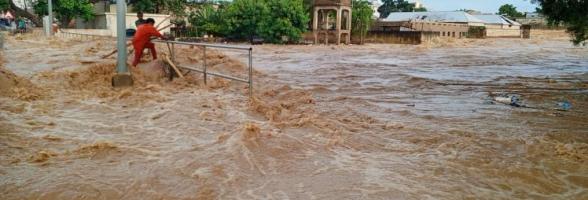By Janice Ian Manlutac & Mustafa Ahmed
The caravans of camels towering over small trees in the vast semi-arid land is truly a sight to behold.
For pastoralist and semi-pastoralist communities in Wadamago, a historic town in Aynabo District in the Sool region of Somaliland, traveling as much as 10 to 50 kilometres to get to a water point for their livestock is a necessity. During the Jilaal's dry season from December to March, adjacent rainfed water sources dry up.
Welcome to Wadamago!
In the past, Wagadamo was known to have a 40 feet deep cave well made of limestone enough to supply nomads and their livestock nearby. In fact, according to one of the herders we met, the town’s name originated from the phrase Wadaamo go', meaning wadaan breaker in Somali. A wadaan was a watertight round cylinder bucket made of animal skin which was lowered to a well to carry water. These days, the modern version is a black PVC bucket still tied to a rope that people can lower to the well to get water.
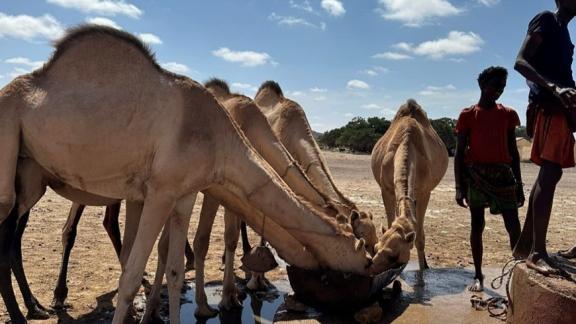
Camels line up neatly in intervals of four to drink from a large basin while their herders watch nearby. Photo credit: Ahmed Osman/ Oxfam
Follow the water
Climate change has disrupted the water supply in these parts of the world and is changing livelihood practices and even cultural dynamics. The shorter and infrequent rainy seasons had not been enough to replenish water source, therefore locals rely on the strategic water boreholes like this one for both animal and human consumption. The most severe drought experienced by the country in 40 years have resulted in a sharp increase in WASH, food, health and nutrition needs, especially in rural areas like Wadamago.
Arriving in one of the bore holes constructed with Oxfam’s support, humans, camels, goats and donkeys take their turns drinking. It was a very well-orchestrated affair.
A few hundred meters away, a structure not normally seen in this town is causing a bit of a buzz among locals. The two units of 8.5 by 41 meters greenhouses was constructed with Oxfam’s support and is part of the multi-year resilience project Realizing the Triple Nexus Approach through Complementarity Area-Based Disaster Risk Management, Early Warning and Livelihoods Work supported by Irish Aid.
Greenhouse of hope
After extensive community dialogues and assessments, the greenhouse and the farming technology that comes with it is Oxfam’s attempt to provide predictable and climate friendly income streams to the community. Although it is still at an early stage—the greenhouses were just constructed in November 2023--one can already see their potential to be game changers for this community.
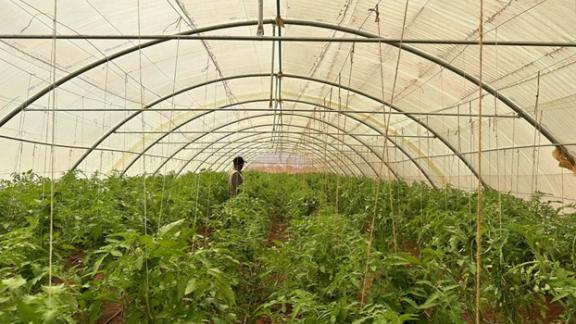
Mustafe Ahmed, Livelihoods and Economic Growth Coordinator of Oxfam Somali Program shows the scale of the greenhouse. The capital investment including the materials use for constructing one greenhouse is $7000. Each greenhouse has been planted with 1,000 units of tomatoes. Photo credit: Janice Manlutac/ Oxfam
Each cropping cycle is six months and uses high quality indeterminate tomato seed. If all goes well, each tomato plant can produce a minimum of 10 and a maximum of 50 kgs per harvest cycle. In the market, the average cost per kilo of a tomato is $1. This means that in the first harvest, the capital investment can be recovered even with minimum harvest which will bring an estimated $10,000. The surplus income can then be reinvested for the new crop, repairs of the greenhouse if needed, and for savings. Eventually, the Cooperative plans to save enough to construct a few more greenhouses and then divide income amongst themselves.
Apart from the income, one important benefit the community is celebrating is their ability to work together and resolve issues peacefully. In other parts of the Sool region, similar attempts of innovating farming practices have led to reduced migration and displacement. Herds are able to feed from the farms and in the long run, farmers said they hope to produce enough food for themselves and keep surplus during disasters.
“All of us are excited and committed to this greenhouse. Our community is pooling resources to secure and protect the facility. Because this is new, we are still learning a lot. We are not used to farming together like this or working together in one place, but it is amazing that after the three months training on new technological farming from the agronomist provided by Oxfam, we can now grow food that we can sell and augment income from our livestock,” says Asha Mohamed Ali, 47 years old, leader of the cooperative managing the greenhouses.
In the surrounding land, men and women have dug up vegetable plots for onions and other in-demand vegetables. They are still testing and experimenting which ones can survive drought-like conditions. Like keen science students, they regularly monitor to understand patterns of plant survival. Meantime, they have built proper irrigation lines with water tanks to have a steady supply of water. They said they want to continue taking care of their livestock and skill up to diversify their income.

Asha and Mustafe inspect tomatoes and their readiness for harvest. Photo credit: Janice Manlutac/ Oxfam
Triple nexus approach in action
This multi-faceted project aims to adopt a layered, area-based holistic approach to tackle the key factors driving insecurity for poor and vulnerable pastoralist and agro-pastoralist communities of Somaliland. Restoration of community infrastructures, such as social, water combined with rangeland conservation, and entrepreneurial training will strengthen the affected communities’ capacities to prepare, respond and adopt to crisis.
To demonstrate what this means, a water borehole was created with partner communities providing labour equity as well as water management to ensure peaceful and inclusive utilization of water. This water system is then linked with pipes to provide water and irrigation to the farmland and greenhouses nearby. In the same vicinity, a local veterinary supply store and clinic was established in partnership with the Ministry of Livestock and Fishery Development (MoDFD) to take care of livestock health issues. Meantime, various associations, and cooperatives such as a women meat sellers’ group have been organized and was supported to establish linkages with key markets in the region. Alongside this is an advocacy for more investment and policy changes from financial service providers and government authorities.
“We need to invest in the triple nexus. This means having multi-year programs that has built in development, peace building and of course, crisis modifiers during emergencies. One off emergency response will not work in these complex contexts. Sometimes these short-term responses feel like a marathon and although lifesaving, are not creating much impact,” according to Mustafa Ahmed, Oxfam Somali Resilience Program Coordinator.
As climate crisis worsens, Oxfam Somali, working side by side communities, believes that to transform this situation, it needs to move away from solely reactive responses of humanitarian aid when drought or conflicts strike.
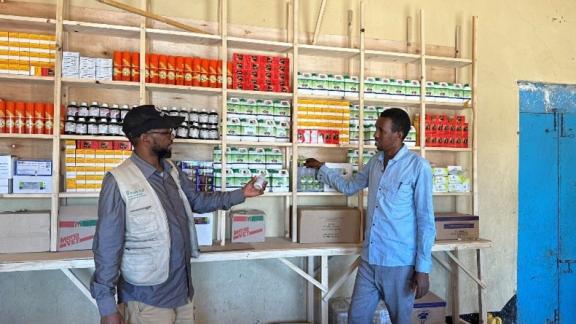
Wadamago Pharmacy and Veterinary was made possible with funds from Irish Aid. Technicians and pharmacist are provided by the Ministry of Livestock and Fishery Development (MoDFD). Photo credit: Janice Manlutac/ Oxfam
